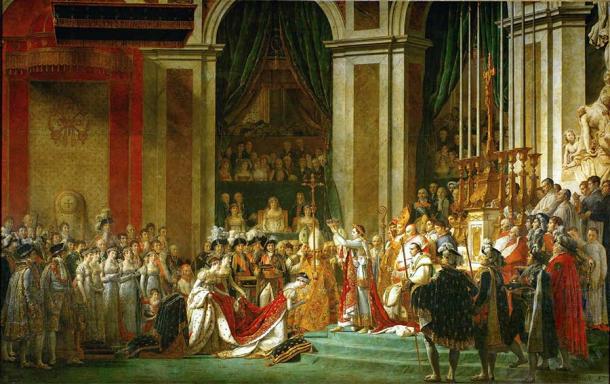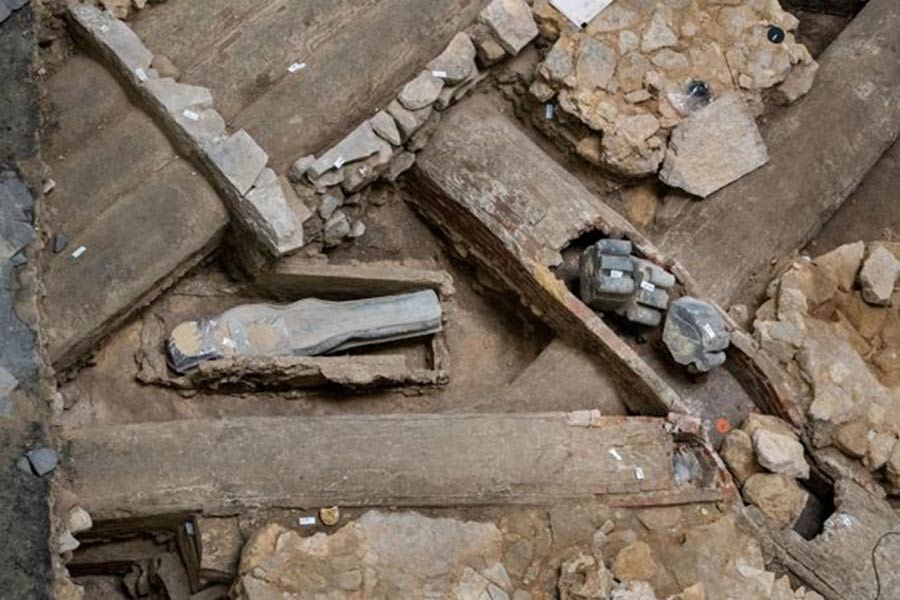Mysterious Notre Dame Lead Sarcophagus Will be Opened!
In April 2019, a devastating fire engulfed the historical Notre Dame Cathedral in the heart of Paris, built at a time when France was moving towards its identity as a nation, all the way back in the 12th and 13th centuries. As the nation looked on in tears and horror, members of the business and political elite were quick to reassure a shocked public that rebuilding this monument integral to French identity was a priority.
Surprise Finds: Mysterious Notre Dame Sarcophagus and Sculptures
In the midst of the restoration of Notre Dame and its rebuilding, archaeologists uncovered a lead sarcophagus which may date back to the 14th century . “The floor of the transept crossing has revealed remains of remarkable scientific quality,” France's Culture Minister Roselyne Bachelot said. The French experts have described their discoveries as both “extraordinary and emotional.” Christophe Besnier, the leader of the scientific team said:
“We uncovered all these riches just 10-15cm under the floor slabs. It was completely unexpected. There were exceptional pieces documenting the history of the monument. It was an emotional moment. Suddenly we had several hundred pieces from small fragments to large blocks including sculpted hands, feet, faces, architectural decorations and plants. Some of the pieces were still coloured.”

The head of a statue that experts believe may be Jesus. (Denis Gliksman/Inrap)
The discoveries were made at the ancient church’s spire at the central spot where the transept crosses the nave. The Guardian reports that one of the “most extraordinary pieces” is the intact stone sculpture of a man’s head, which is believed to be a representation of Jesus. A press release by the French Ministry of Culture and Communication described another fantastic find - a “completely preserved, human-shaped sarcophagus made of lead.”
- Notre Dame: How a Rebuilt Cathedral Could Be Just as Wonderful
- Thieves Attack Notre-Dame During Paris Lockdown
“We were able to send a small camera inside which showed cloth remains, organic matter such as hair and plant remains,” explained Christophe Besnier, the lead archaeologist. “You can glimpse pieces of fabric, hair and a pillow of leaves on top of the head, a well-known phenomenon when religious leaders were buried. The fact that these plant elements are still inside means the body is in a very good state of conservation.”
Experts believe the lead sarcophagus probably belonged to a dignitary from the early 14th century – a very exciting prospect for a better understanding of the Middle Ages, particularly funeral practices, according to Dominique Garcia of the National Institute of Archaeological Research. Ahead of installing scaffolding to rebuild the spire, precautionary testing had been carried out to check the stability of the ground. During this process, an underground heating system from the 19th century was discovered with the sarcophagus lying among the brick pipes.
The Notre Dame: A History of Destruction
AFP reports that other parts of the structure which had been destroyed in the early 18th century at the time of the French Revolution and unearthed during the subsequent restoration in the mid-1800s, are already on display at the Louvre Museum.
This is not the only time that Notre Dame has faced destruction or an attack to its very structure – it stems to all the way back when the cathedral of Saint-Etienne, which stood for over 400 years today where the Notre Dame stood, was destroyed in favor of a new cathedral dedicated to the Virgin Mary.
Even before the French Revolution, rot had taken control of the historic building – it lay dilapidated, unmaintained, dirty, and this became the subject of an incensed Victor Hugo’s seminal novel from 1831, a gothic masterpiece popularly known as The Hunchback of Notre-Dame. This was despite Napoleon Bonaparte choosing the famous cathedral as the venue for his coronation in 1804.

The coronation of Napoleon I and Josefina at Notre Dame Cathedral in Paris in 1804. (Public domain)
The French Revolution , however, witnessed all elements of church, state, and religion experiencing the wrath of the people. Revolutionaries tore down 28 statues of kings’ houses in the Notre Dame, and many other statues of religious figures, save the one of Virgin Mary. The original spire erected in the 13th century was also torn down and renamed the temple complex in honor of the Goddess of Reason – a by-product of enlightenment thought which questioned the role of religion in the manipulation of the social fabric.
- Ancient Skills Used to Raise Roof at Notre Dame Cathedral
- Ashes of Notre-Dame to Reveal Secrets of Medieval Architecture
It was only under the tutelage of architect Eugène-Emmanuel Viollet-le-Du that a major renovation project starting in 1843 was begun – it took 20 years! This was the Notre Dame that we saw till 2019, with the old spire being replaced, sculpted gargoyles added (some of which were lost in the fire), and the painting of new murals, reports Live Science. With the goal of the 2024 Olympics in Paris in mind, the renovation team, under the watchful eye of Jean-Louis Georgelin, is confident of restoring the Notre Dame back to its glory.
“The Minister of Culture and Army General Jean-Louis Georgelin, president of the public establishment, are delighted with these discoveries which will enrich our understanding of the history of Notre-Dame de Paris,” concludes the press release when discussing the artifacts and the Notre Dame sarcophagus uncovered during restoration work in Paris.
The Mysterious Notre Dame Lead Sarcophagus Will be Opened
Dominique Garcia said further examinations will be carried out and the sarcophagus will be opened so scientists can perform DNA tests on the remains, but also noted “A sarcophagus containing a human body is not an archaeological object. These are human remains, and while examining the sarcophagus and analysing the body and other objects inside, we must do so with respect.”
No decision has been made yet about where the body will be reburied when the testing is completed, however Garcia said that “it’s possible that it will be reburied somewhere in the cathedral.”
Top image: The mysterious lead sarcophagus found at Notre Dame surrounded by 19th century piping. Source: Denis Gliksman/ Inrap
By Sahir Pandey
Updated on April 16, 2022.



















